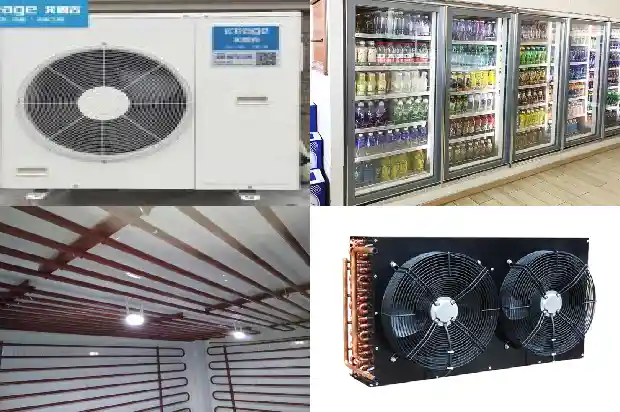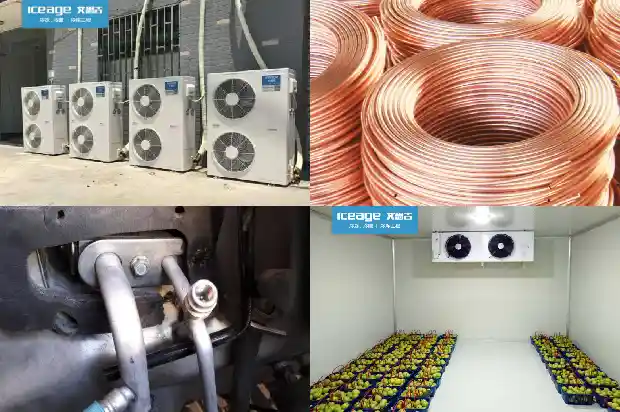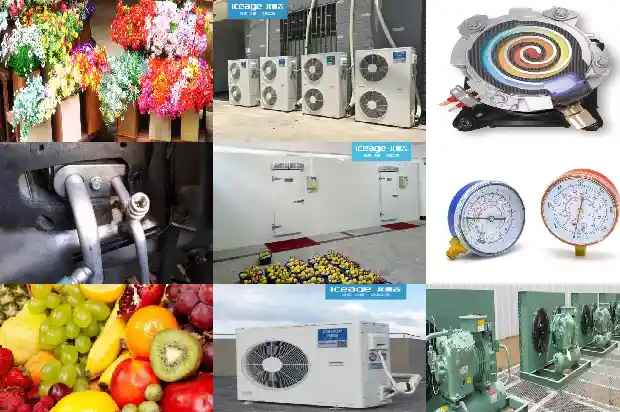Compare Various Refrigerants: Gain Quick Insights into Each Characteristic
2025-03-17
At present, the refrigerant widely used in household air - conditioners and heat pumps is R22. It belongs to the ozone - depleting substance HCFC. According to the Montreal Protocol, China will phase out the production and consumption of all HCFCs in the manufacturing industry by 2030 [1]. The alternative refrigerants for R22 can be roughly divided into three categories:
The first category is HFC refrigerants, such as R410a (already widely used) and R32 (a potential refrigerant).
The second category is HC hydrocarbon refrigerants, such as R290 (a potential refrigerant).
The third category is the natural working fluid carbon dioxide CO₂. Due to its high working pressure, it is generally not used in household air - conditioners.
Currently, the focus of refrigerants for household air - conditioners mainly lies on R22, R410a, R32, and R290. As a media in the refrigeration industry, Refrigeration Encyclopedia believes it is necessary to popularize their safety knowledge.
The safety of refrigerants mainly includes toxicity and flammability. The national standard "Refrigerant Designation and Safety Classification" GB/T 7778 - 2017 classifies the toxicity of refrigerants into category A (low chronic toxicity) and category B (high chronic toxicity), and classifies flammability into Class 1 (no flame propagation), Class 2L (weak flammability), Class 2 (flammability), and Class 3 (flammable and explosive). According to GB/T 7778 - 2017, the safety of refrigerants is subdivided into 8 categories, namely: A1, A2L, A2, A3, B1, B2L, B2, B3. Among them, A1 is the safest and B3 is the most dangerous [2].
The first category is HFC refrigerants, such as R410a (already widely used) and R32 (a potential refrigerant).

The second category is HC hydrocarbon refrigerants, such as R290 (a potential refrigerant).
The third category is the natural working fluid carbon dioxide CO₂. Due to its high working pressure, it is generally not used in household air - conditioners.
Currently, the focus of refrigerants for household air - conditioners mainly lies on R22, R410a, R32, and R290. As a media in the refrigeration industry, Refrigeration Encyclopedia believes it is necessary to popularize their safety knowledge.
The safety of refrigerants mainly includes toxicity and flammability. The national standard "Refrigerant Designation and Safety Classification" GB/T 7778 - 2017 classifies the toxicity of refrigerants into category A (low chronic toxicity) and category B (high chronic toxicity), and classifies flammability into Class 1 (no flame propagation), Class 2L (weak flammability), Class 2 (flammability), and Class 3 (flammable and explosive). According to GB/T 7778 - 2017, the safety of refrigerants is subdivided into 8 categories, namely: A1, A2L, A2, A3, B1, B2L, B2, B3. Among them, A1 is the safest and B3 is the most dangerous [2].
01
R22: The Refrigerant to be Phased Out
The chemical composition of R22 is chlorodifluoromethane (CHClF₂). It is non - combustible, non - explosive, and has very low toxicity. Its safety level belongs to A1.
R22 has an ozone - depleting potential ODP > 0. Therefore, it is not suitable for long - term use. China will completely phase it out by 2030.
R22: The Refrigerant to be Phased Out
The chemical composition of R22 is chlorodifluoromethane (CHClF₂). It is non - combustible, non - explosive, and has very low toxicity. Its safety level belongs to A1.
R22 has an ozone - depleting potential ODP > 0. Therefore, it is not suitable for long - term use. China will completely phase it out by 2030.
02
R410A: The Alternative Refrigerant for R22
R410A is composed of R32 and R125 in a mass fraction ratio of 50% each. Among them, R32 (difluoromethane CH₂F₂, A2L) and R125 (pentafluoroethane CF₃CHF₂, A1), the safety level of R410A is A1. It is also a non - combustible, non - explosive, and low - toxicity working fluid.
Compared with R22, R410a is a high - pressure refrigerant, which requires higher pressure resistance for equipment and systems. However, it is beneficial for reducing the displacement of the compressor, reducing the diameter of heat - exchange copper pipes, and saving raw materials. The heat - transfer and flow characteristics of R410a are superior to those of R22, which is conducive to improving the operating efficiency of air - conditioners and has obvious energy - saving effects. Currently, it has been widely used.
The ODP of R410a is 0, which means it does not deplete the ozone layer. However, the global warming potential GWP of R410a is 1730 (for comparison, the GWP of CO₂ is 1), which has a relatively large promoting effect on global warming. Therefore, R410A is not the ultimate solution for environmentally friendly refrigerants.
R410A: The Alternative Refrigerant for R22
R410A is composed of R32 and R125 in a mass fraction ratio of 50% each. Among them, R32 (difluoromethane CH₂F₂, A2L) and R125 (pentafluoroethane CF₃CHF₂, A1), the safety level of R410A is A1. It is also a non - combustible, non - explosive, and low - toxicity working fluid.
Compared with R22, R410a is a high - pressure refrigerant, which requires higher pressure resistance for equipment and systems. However, it is beneficial for reducing the displacement of the compressor, reducing the diameter of heat - exchange copper pipes, and saving raw materials. The heat - transfer and flow characteristics of R410a are superior to those of R22, which is conducive to improving the operating efficiency of air - conditioners and has obvious energy - saving effects. Currently, it has been widely used.
The ODP of R410a is 0, which means it does not deplete the ozone layer. However, the global warming potential GWP of R410a is 1730 (for comparison, the GWP of CO₂ is 1), which has a relatively large promoting effect on global warming. Therefore, R410A is not the ultimate solution for environmentally friendly refrigerants.
03
R32: A Competitor for Future Refrigerants
The chemical composition of R32 is difluoromethane CH₂F₂. It has very low toxicity and is slightly flammable, with a safety level of A2L. There is a possibility of explosion for R32, and its explosion limit is 14.4% - 29.3% [3]. The problem of low flammability needs to be solved in the application of household air - conditioners.
The refrigeration performance of R32 is close to that of R410a. Under the condition of the same refrigeration capacity, the filling amount of R32 is less than that of R410a (about 30% less), but its exhaust temperature is higher than that of R410a. The ODP of R32 is 0, and the GWP is 675. It belongs to a green and environmentally friendly refrigerant and is an important substitute for R22.
R32: A Competitor for Future Refrigerants
The chemical composition of R32 is difluoromethane CH₂F₂. It has very low toxicity and is slightly flammable, with a safety level of A2L. There is a possibility of explosion for R32, and its explosion limit is 14.4% - 29.3% [3]. The problem of low flammability needs to be solved in the application of household air - conditioners.
The refrigeration performance of R32 is close to that of R410a. Under the condition of the same refrigeration capacity, the filling amount of R32 is less than that of R410a (about 30% less), but its exhaust temperature is higher than that of R410a. The ODP of R32 is 0, and the GWP is 675. It belongs to a green and environmentally friendly refrigerant and is an important substitute for R22.

04
R290: A Competitor for Future Refrigerants
The chemical composition of R290 is propane (CH₃CH₂CH₃). It has very low toxicity and is flammable, with a safety level of A3. The explosion limit of R290 is 2.1% - 10.0% [3], and its explosion point is much lower than that of R32.
The ODP of R290 is 0, and the GWP is 20, which has a very small promoting effect on global warming. It belongs to a natural organic substance and can be directly obtained from liquefied petroleum gas, with a low price. R290 has good thermal performance, a large latent heat of vaporization, and a small system charging amount. Under the same working conditions, the exhaust temperature can be 20℃ lower than that of R22, which is beneficial for extending the service life of the compressor.
In 2020, R290 gradually came into the spotlight.
The biggest obstacle to the promotion and application of R290 is the flammability issue. During the use process, more safety measures need to be taken to ensure that its filling amount is controlled within the value specified by relevant regulations (Standard IEC60335 - 2 - 24: 2007). Currently, the safety of R290 can be controlled in household air - conditioners with < 1.
R290: A Competitor for Future Refrigerants
The chemical composition of R290 is propane (CH₃CH₂CH₃). It has very low toxicity and is flammable, with a safety level of A3. The explosion limit of R290 is 2.1% - 10.0% [3], and its explosion point is much lower than that of R32.
The ODP of R290 is 0, and the GWP is 20, which has a very small promoting effect on global warming. It belongs to a natural organic substance and can be directly obtained from liquefied petroleum gas, with a low price. R290 has good thermal performance, a large latent heat of vaporization, and a small system charging amount. Under the same working conditions, the exhaust temperature can be 20℃ lower than that of R22, which is beneficial for extending the service life of the compressor.
In 2020, R290 gradually came into the spotlight.

The biggest obstacle to the promotion and application of R290 is the flammability issue. During the use process, more safety measures need to be taken to ensure that its filling amount is controlled within the value specified by relevant regulations (Standard IEC60335 - 2 - 24: 2007). Currently, the safety of R290 can be controlled in household air - conditioners with < 1.

Related Articles
- What Are the Commonly Used Refrigerants in Refrigerators and Cold Storages?
- Types of Refrigerants and Leak - detection Methods
- Four Combustible and Explosive Refrigerants: Precautions When in Use!
- Scheme for the Use and Safety of Ammonia Refrigerants
- Introduction to the Relationship between Refrigerants and Cold Storage Temperatures
- Four types of flammable and explosive refrigerants
- Performance of Eco-friendly Refrigerants 410A and R407C
- The characteristics and uses of 26 types of air conditioning refrigerants
